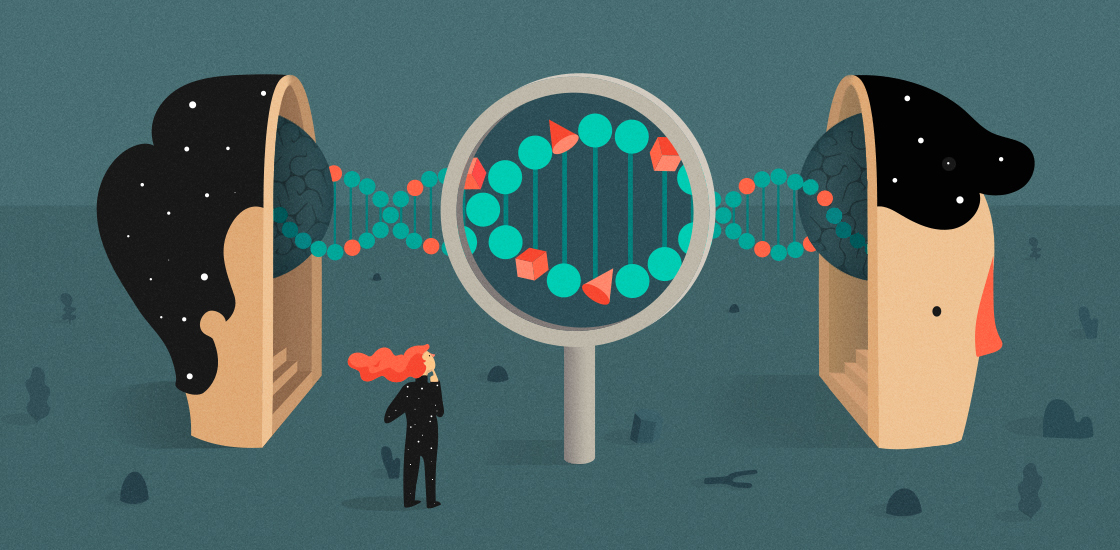THIS ARTICLE IS MORE THAN FIVE YEARS OLD
This article is more than five years old. Autism research — and science in general — is constantly evolving, so older articles may contain information or theories that have been reevaluated since their original publication date.
A chemical tag on DNA that has risen to prominence only in the past few years is altered in people with autism, suggest results from an autism mouse model. The tag, called 5-hydroxymethylcytosine (5-hmC), is thought to turn genes on, mostly in the brain.
The findings, published 30 September in Human Molecular Genetics, hint at a bigger role for this chemical tag in autism than was previously known1.
“[Our findings] show that 5-hmC is playing a role in autism,” says lead researcher Reid Alisch, assistant professor of psychiatry at the University of Wisconsin-Madison. “Early-life influences may be altering 5-hmC in individuals [who] are susceptible to autism, and that can lead to the onset of the disorder.”
The study looked at mice lacking CNTNAP2, a candidate gene for autism. These mice show abnormal distribution of 5-hmC in various regions of the genome that overlap with several autism genes, the researchers found.
It is not known whether these changes contribute to autism-like features in the mutant mice or are a consequence of them. For example, mice lacking CNTNAP2 are prone to seizures, which are known to alter these types of modifications in the brain.
“We really don’t know whether altered 5-hmC is the cause of the phenotype or the consequence of what is happening in the mice,” says Peng Jin, professor of human genetics at Emory University in Atlanta, who was not involved in the study.
Autism connection:
The 5-hmC tag is a modified version of the better-known methyl tag. Both have epigenetic effects — meaning that they alter gene expression without changing the underlying genetic code.
As of six years ago, researchers could not distinguish 5-hmC from a methyl mark. As a result, studies conflated the two types, possibly masking differences between people with autism and controls. “We really need to go back and look at all of the studies that have gone on up until this time,” Alisch says.
In 2009, researchers reported that 5-hmC is 10 times more common in the brain than elsewhere in the body2. Other studies revealed that the mark is highly variable during development and tends to cluster on genes that are turned on, suggesting that it boosts gene expression.
A few studies have shown that the tag is often present on autism genes, suggesting a role in autism3. The new study is the first to link an autism mutation with no known effects on gene expression to changes in 5-hmC patterns.
The researchers looked at the pattern of 5-hmC marks in the striatum — a region deep in the brain that coordinates movement. There are fewer neurons that inhibit brain signals in this region in CNTNAP2 mutant mice than in controls.
They found significant changes in the distribution of 5-hmC in neurons in the striatum of the mutant mice compared with controls. At 847 sites in the genome, the mutants gain a 5-hmC mark; at another 801 locations, they appear to have lost it. Most sites with an abundance of 5-hmC land in the coding sequences of genes, supporting the idea that the tag enhances expression of these genes.
Of the genes that show an increase in 5-hmC marks, 68 are known to have strong links to autism. The tag is also often on genes involved in autism-associated pathways.
“All the pathways that we talk about and know about being involved in autism have some level of differential 5-hmC modification,” says Alisch.
Masking differences:
CNTNAP2 is not the first autism-associated gene shown to influence 5-hmC patterns. Mice lacking MeCP2, the gene mutated in the autism-like disorder Rett syndrome, have more 5-hmC marks than controls do. This finding makes sense given that MeCP2 is known to bind to a protein needed to form the 5-hmC tag, says Jin.
CNTNAP2, by contrast, has no known role in regulating gene expression. Instead, it forms connections between neurons and other types of brain cells and helps secure electrical channels in neuronal membranes.
Researchers typically focus on how DNA tags influence gene expression. Few studies have looked at how mutations in genes unrelated to epigenetics may in turn affect the tags, says Dennis Grayson, professor of molecular neuroscience at the University of Illinois at Chicago. How and why CNTNAP2 loss affects 5-hmC is still unknown, but “I’d like to know more about what’s going on,” Grayson says.
The researchers looked at the distribution of 5-hmC marks in adult mice, but it would be interesting to track them over the course of development, says Jin. He and his colleagues have shown that many 5-hmC marks emerge as 2-week-old juvenile mice grow into 8-week-old adults, for example. These same marks also seem to be the ones affected in mice lacking MeCP2; the same may be true for mice lacking CNTNAP2, Jin says.
Alisch and his colleagues are investigating how experience may influence both autism features and the distribution of 5-hmC in the CNTNAP2 mutant mice.

By joining the discussion, you agree to our privacy policy.